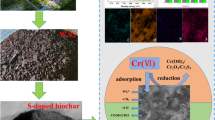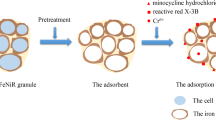Abstract
Safe, efficient, and simultaneous treatment of toxic industrial sludge and anionic contaminant crisis in one route still remains a persistent global challenge. Herein, we proposed a facile waste-control-waste conceptual design strategy to develop low-cost and high-performance sludge-based adsorbent for not only recycling of toxic waste nickel-containing sludge (NCS) but for the efficient removal of anionic contaminants in wastewater. The as-designed Ni–Al layered double oxides/calcined NCS (Ni–Al LDOs/CNCS) (216.96 m2/g, 0.44 cm3/g) with hierarchical porous structure possessed a larger specific surface area and well-developed porosity compared with raw NCS (60.52 m2/g, 0.26 cm3/g). It was proved that a higher hydrothermal temperature (180 °C) and a longer hydrothermal time (24 h) both promote the in situ assembly of LDHs nanosheets on CNCS surface. Significantly, the sludge-based adsorbent displayed high adsorption capacity towards five representative anions including F− (~ 31.1 mg/g), SO42− (~ 37.7 mg/g), NO3− (~ 21.8 mg/g), Cl− (~ 28.0 mg/g), and H2PO4− (~ 35.8 mg/g). Furthermore, the adsorbent maintained desirable adsorption capacity even after 6 adsorption/desorption cycles. Therefore, this study could be potentially extended toward design of other industrial waste sludge–derived high value-added advanced materials and for wastewater treatment applications.





Similar content being viewed by others
Data availability
All data generated or analyzed during this study are included in this published article (and its supplementary information files).
References
Amrane C, Bouhidel K-E (2018) Integrated diffusion dialysis precipitation – cementation for selective recovery of leaching chemicals and metal values from electroplating sludge. Hydrometallurgy 177:34–40
Chang Z, Long G, Zhou JL, Ma C (2020) Valorization of sewage sludge in the fabrication of construction and building materials: a review. Resour Conserv Recy 154:104606
Chen H, Sun J, Song Y, Zhao Z, Sun Q, Ye F, Peng Q, Zhang Q (2022) New insight into the bioinspired sub-10 nm Sn(HPO4)2 confinement for efficient heavy metal remediation in wastewater. J Colloid Interface Sci 609:676–685
Chen M, Zhu L, Chen J, Yang F, Tang CY, Guiver MD, Dong Y (2020) Spinel-based ceramic membranes coupling solid sludge recycling with oily wastewater treatment. Water Res 169:115180
Chen Y, Zhao B, Zhang H, Zhang T, Yang D, Feng X (2022) Laminated PET-based membranes with sweat transportation and dual thermal insulation properties. Chem Eng J 450:138177
Huang H, Liu J, Zhang P, Zhang D, Gao F (2017) Investigation on the simultaneous removal of fluoride, ammonia nitrogen and phosphate from semiconductor wastewater using chemical precipitation. Chem Eng J 307:696–706
Jung K-W, Lee SY, Choi J-W, Hwang M-J, Shim WG (2021) Synthesis of Mg–Al layered double hydroxides-functionalized hydrochar composite via an in situ one-pot hydrothermal method for arsenate and phosphate removal: structural characterization and adsorption performance. Chem Eng J 420:129775
Karthikeyan P, Meenakshi S (2019) In-situ fabrication of zirconium entrenched biopolymeric hybrid membrane for the removal of toxic anions from aqueous medium. Int J Biol Macromol 141:1199–1209
Li Z, Gou M, Yue X, Tian Q, Yang D, Qiu F, Zhang T (2021) Facile fabrication of bifunctional ZIF-L/cellulose composite membrane for efficient removal of tellurium and antibacterial effects. J Hazard Mater 416:125888
Li Z, Qiu F, Tian Q, Yue X, Zhang T (2022) Production and recovery of tellurium from metallurgical intermediates and electronic waste-A comprehensive review. J Cleaner Prod 366:132796
Liu C, Zhang M, Pan G, Lundehøj L, Nielsen UG, Shi Y, Hansen HCB (2019) Phosphate capture by ultrathin MgAl layered double hydroxide nanoparticles. Appl Clay Sci 177:82–90
Nazmara S, Oskoei V, Zahedi A, Rezanasab M, Shiri L, Fallahizadeh S, Vahidi-Kolur R (2022) Removal of humic acid from aqueous solutions using ultraviolet irradiation coupled with hydrogen peroxide and zinc oxide nanoparticles. Int J Environ Anal Chem 102:1583–1597
Prasanna SV, Rao RAP, Kamath PV (2006) Layered double hydroxides as potential chromate scavengers. J Colloid Interface Sci 304:292–299
Qian T, Lu D, Soh YNA, Webster RD, Zhou Y (2020) Biotransformation of phosphorus in enhanced biological phosphorus removal sludge biochar. Water Res 169:115255
Song Y, Song X, Sun Q, Wang S, Jiao T, Peng Q, Zhang Q (2022) Efficient and sustainable phosphate removal from water by small-sized Al(OH)3 nanocrystals confined in discarded artemia cyst-shell: ultrahigh sorption capacity and rapid sequestration. Sci Total Environ 803:150087
Tan K-J, Morikawa S, Phillips KR, Ozbek N, Hatton TA (2022) Redox-active magnetic composites for anionic contaminant removal from water. ACS Appl Mater Interfaces 14:8974–8983
Tian Q, Qiu F, Yue X, Li Z, Zhao B, Zhang T (2021) Surface structure regulation of wastewater flocculated sludge for hierarchical superhydrophobic ceramic coating. J Environ Chem Eng 9:106851
Tian Q, Qiu F, Li Z, Xiong Q, Zhao B, Zhang T (2022) Structured sludge derived multifunctional layer for simultaneous separation of oil/water emulsions and anions contaminants. J Hazard Mater 432:128651
Tounsi H, Chaabane T, Omine K, Sivasankar V, Sano H, Hecini M, Darchen A (2022) Electrocoagulation in the dual application on the simultaneous removal of fluoride and nitrate anions through respective adsorption/reduction processes and modelling of continuous process. J Water Process Eng 46:102584
Vunnava VSG, Singh S (2019) Entropy generation analysis of sequential anaerobic digester ion-exchange technology for phosphorus extraction from waste. J Cleaner Prod 221:55–62
Wang S, Wang F, Jin Y, Meng X, Meng B, Yang N, Sunarso J, Liu S (2021) Removal of heavy metal cations and co-existing anions in simulated wastewater by two separated hydroxylated MXene membranes under an external voltage. J Membrane Sci 638:119697
Wang Y, Xu Y, Lin S, Liu W, Wang Y (2022) Recycling of chromium electroplating sludge using combined calcination-hydrothermal treatment: a risk-reducing strategy for separation of Cr(III) from solid waste. Surf Interfaces 29:101750
Yan H, Chen Q, Liu J, Feng Y, Shih K (2018) Phosphorus recovery through adsorption by layered double hydroxide nano-composites and transfer into a struvite-like fertilizer. Water Res 145:721–730
Yong Y, Hua W, Jianhang H (2021) Co-treatment of electroplating sludge, copper slag, and spent cathode carbon for recovering and solidifying heavy metals. J Hazard Mater 417:126020
Yousefi M, Gholami M, Oskoei V, Mohammadi AA, Baziar M, Esrafili A (2021) Comparison of LSSVM and RSM in simulating the removal of ciprofloxacin from aqueous solutions using magnetization of functionalized multi-walled carbon nanotubes: process optimization using GA and RSM techniques. J Environ Chem Eng 9:105677
Zhang W, Yang X, Lin C, Feng J, Wang H, Yan W (2021) Insight into the effect of surfactant modification on the versatile adsorption of titanate-based materials for cationic and anionic contaminants. Chemosphere 269:129383
Zhang Y, Cui Y, Zhang J, Xu Y, Liu Q, Qian G (2022) Synthesis of electrocatalyst from electroplating sludge for efficient N2 reduction under ambient conditions. Chem Eng J 429:132357
Funding
This work was financially supported by the National Natural Science Foundation of China (21706100 and 21878132), China Postdoctoral Science Foundation (2020M681740 and 2021T140578), Natural Science Foundation of Hebei Province (E2021108005), 333 Talent Project Foundation of Hebei Province (A202101029), Natural Science Foundation of Jiangsu Province (BK20211126) and Postgraduate Research & Practice Innovation Program of Jiangsu Province (KYCX21_3388 and SJCX22_1856).
Author information
Authors and Affiliations
Contributions
Qiong Tian: investigation, formal analysis, methodology, writing—original draft. Zhipeng Lin: investigation. Fengxian Qiu: supervision, project administration, writing—review and editing. Zhangdi Li: visualization, software. Qing Guo: investigation. Tao Zhang: supervision, writing—review and editing.
Corresponding author
Ethics declarations
Ethics approval and consent to participate
Not applicable.
Consent for publication
Not applicable.
Conflict of interest
The authors declare no competing interests.
Additional information
Responsible Editor: Tito Roberto Cadaval Jr
Publisher's note
Springer Nature remains neutral with regard to jurisdictional claims in published maps and institutional affiliations.
Supplementary Information
Below is the link to the electronic supplementary material.
Rights and permissions
Springer Nature or its licensor holds exclusive rights to this article under a publishing agreement with the author(s) or other rightsholder(s); author self-archiving of the accepted manuscript version of this article is solely governed by the terms of such publishing agreement and applicable law.
About this article
Cite this article
Tian, Q., Lin, Z., Qiu, F. et al. Recyclable structured toxic industrial nickel-containing sludge for efficient anionic contaminant adsorption. Environ Sci Pollut Res 29, 64259–64265 (2022). https://doi.org/10.1007/s11356-022-22523-w
Received:
Accepted:
Published:
Issue Date:
DOI: https://doi.org/10.1007/s11356-022-22523-w




